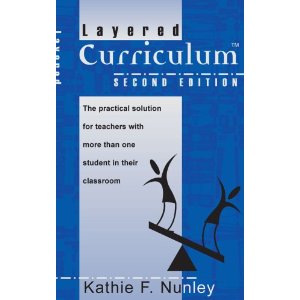I firmly believe sometimes we make this “teaching” thing entirely too freaking complicated.

Kids are kids. They act like kids. When they don’t want to do something they whine, complain and generally do anything they can to avoid doing it. Actually, it’s not all that much different than adults when you think about it. The only difference is that for kids “avoidance behavior” may look like throwing pencils, rocking their desk on two legs, playing with the hair of the girl in front of them or texting their friends if they think they can get away with it.
Adult avoidance behavior, we sophistically call it procrastination, appears more productive on the surface (that’s how we justify it) and it may look like balancing a checking account, finding excuses to chit-chat with colleagues, or oddly enough, texting a friend if they think they can get a way with it. Hell, if the faculty meeting is bad enough I’ve even been known to throw a pencil or two.
Two years into my teaching career I was dangerously close to becoming one of the thousands of teachers who leaves the profession in their first five years. As we have famously heard time and time again, 50% of them do.
So there I was, November of my third year talking to my principal about possible alternatives in the educational world. I was considering moving my career towards Alternative schools for At-Risk kids or perhaps Special Education.
Yet, the “classroom grind” had become overwhelming. Facing my classroom full of students with a wide range of abilities and a wider range of “avoidance behaviors” I was convinced at the ripe old age of 25 that “kids today are just different.” Yet while it’s easy, and occasionally humorous, to blame bad parenting, popular music, economics or the Internet, the truth is my assignments sucked and I wouldn’t have wanted to do them either. Shoot, I don’t like to do things my principal asks of me unless she can convince me “why” I should do them, yet I expected my students to demonstrate the maturity to do as asked with no true motivation beyond “Mr. Clements said so!” ? Epic fail.
Around that time the chairperson of our district Professional Development committee (who was also on my grade level team and a good friend of mine) mentioned she wanted to attend a workshop offered through the Department of Elementary and Secondary Education’s (DESE, the state of Missouri’s governing body for education) and the Regional Professional Development Center. The RPDC is an arm of DESE, and our local chapter, Heart of Missouri, was offering a workshop on Dr. Kathie Nunley’s Layered Curriculum®. (www.help4teachers.com)
The workshop was presented by Steve Ritter, who is currently the principal at Lakeland High School in Missouri but at the time was teaching High School Social Studies at Clinton High School. Steve is a certified trainer of Layered Curriculum and has been a phenomenal resource for me in my career. If you're interested in bringing Layered Curriculum to your school or have other professional inquiries you can visit Steve's website at MrRitter.com.
If you’re interested in learning more about Layered Curriculum you can check out my “Differentiating Instruction Using Layered Curriculum” post elsewhere on this site. As sure as I type this though I can tell you what I’ve gained from using it and from having absorbed all that Dr. Kathie Nunley has to offer goes far beyond a mere method of instruction. It’s an outlook on education.
Dr. Nunley looks at “avoidance behaviors” the same way zoologists look at monkey’s flinging poop against the walls of the cage. It’s not explainable; it’s simply “captive behavior”. Go to the mall or to a park and observe kids and you won’t see them doing any of the crap they do in our classrooms. Why do they do it? It’s captive behavior! In the “real world” we all love to allude to when stressing the importance of responsibility, learning is almost ALWAYS driven by the LEARNER. Adults rarely are forced to learn something they have no desire to learn. Even if required by a boss or employer, the desire to keep our job and pay the rent is motivation enough. And even then as an example, do we really learn it as well as we learn things we have a genuine curiosity in?
So how do we avoid these behaviors and encourage motivation in students? Simple – we grant them the power of choice. By providing students with choices in how they demonstrate understanding of an objective, we provide them a sense of ownership over the material and the “illusion of control” over a situation. They inherently take more pride in their work, after all, they chose it. Furthermore, granting choices allows for teacher and student to work together to reach a variety of learning styles from auditory, visual, and tactile learners as well as English Language Learners and Special Education students.
My students are given choices for virtually every assignment you would have them do. Honestly, this is probably the best thing I’ve ever done for myself and my students. They’re so much happier and thus, so am I.
If students still aren’t engaged despite having an array of choices we have to consider the troubling, yet very real possibility that the choices were offering them just aren’t very good. When forced to choose between a rock and a hard place, adults avoid the situation whenever possible. Students lacking the maturity and mental toughness of an adult can’t be expected to behave differently.
The final key component is to find unique ways of grading assessments to encourage accountability. Nunley suggests Oral Defense grading, which is a book in and of its self, but essentially it just means that rather than grading every little thing that is written down, student and teacher have a mini-conference over a given objective where the teacher asks questions to determine if the student knows the material. No cheating, no matter if the assignment was finished, no papers to grade, no faking it. You either know it or you don’t. If you know, move on. No? Try again. It’s beautiful.
Dr. Nunley’s ideas are grounded in years of classroom experience at the high school level as well as her own research into the human brain and adolescent development. She is quick to point out that the pre-frontal cortex of the brain, responsible for decision-making and responsibility, is not fully developed until at least the late-teens to early twenties. As a result expecting adolescents to always act responsible and make great decisions is a little like asking a five year old to read or a one year old to walk. Some can, some can’t, but it’s unrealistic to expect it from all children at the same time. Responsibility is an aspect of brain development that simply occurs at different times and as a result, we should teach it and encourage it, but not make decisions based on it. Students should be granted multiple opportunities to demonstrate learning and they should be allowed to demonstrate it in a variety of ways.
That’s a lot of information to take in and some fairly radical ideas for a traditional classroom teacher to consider, so please check out my post “Differentiating Instruction Using Layered Curriculum” for more information and a more through explanation. Or you can read Kathie Nunley’s brief synopsis here. If you’re serious about giving it a whirl, I highly recommend Nunley’s book “Layered Curriculum 2nd Edition” on the subject. It is a very easy read and well worth the $25 or so it costs.
Is Layered Curriculum the “magic bullet” so many educators are looking for? Maybe. There are a lot of problems with traditional classroom models and Layered Curriculum provides answers for many of them. However it provides some unique problems as well. Strong classroom management is a must, otherwise a teacher will never be able to juggle having students working on five different things at one time. There’s a lot of pre-teaching that goes into it with regard to parents and students, particularly if you’re subscribing to the traditional grading model that goes along with it. The “min-conferences” may eliminate a lot of take-home paperwork grading for teachers, however it’s HARD WORK spending most class periods trying to churn out as many mini-conferences as possible. There are some aspects of Layered Curriculum I don’t practice much any more for a variety of reasons, but its essential components I’ll never give up.
Yet as I type this I’m on my seventh year of teaching Middle School Social Studies with no immediate plans to do anything else. I firmly believe my students learn more in my class than most and I love that I can spend a lot of time talking about “learning styles” and teaching kids “how to learn” as well as Social Studies.
It may not be the magic bullet, but Layered Curriculum saved my career. And it might have saved a colleague from catching a pencil to head at our next Professional Development Day.




